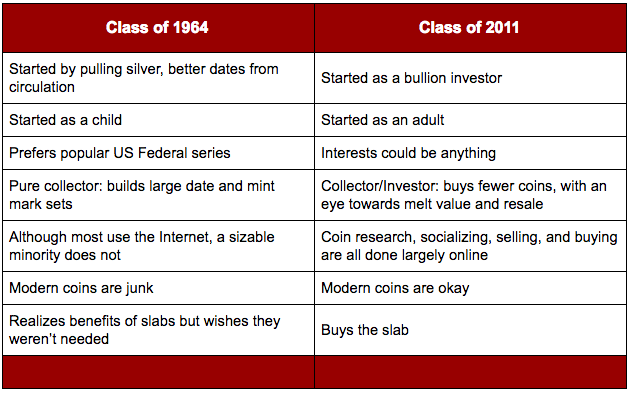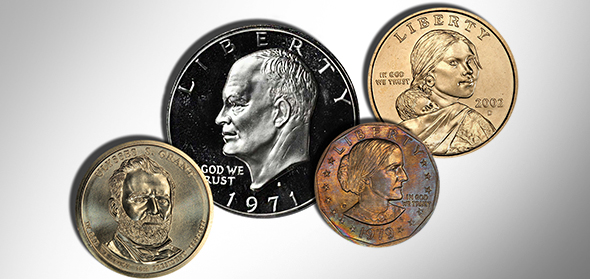
Are you a ’64 or an ’11?
By David Schwager for CoinWeek …..
Coin collecting in the United States went through several surges in popularity, such as in 1857 with the end of the large cent or in the 1934 with the introduction of coin boards (the ancestors of today’s folders and albums). The two periods that most affect the hobby today–creating the largest classes of collectors–are the silver rush of 1964 and the bullion boom of 2011.
The number of coin collectors peaked in the mid-1960s, reaching levels that we will (probably) never see again. With silver coins and silver certificates disappearing and a Congressional hearing on coin shortages, Numismatics was in the news. A sizable number of people turned into savers, speculators, and, as their interest grew, collectors. These members of the “Class of ‘64” are still with us and many of the most prominent and respected numismatists of today belong to this generation.
This generation stayed in the hobby through many crests and valleys, with one of those cycles the remarkable run-up in precious metals prices that started around 2000 and peaked in 2011. Bullion investors with handfuls of American Silver Eagles or generic gold began to wonder what they had bought, with study and time turning some metal buyers into coin collectors. Numismatists who started in the last 10 years are part of the “Class of ‘11”, and many will remain in the hobby past the middle of the 21st century.
This shift that will take American numismatics to 2050 and beyond is not a generation gap or a generational divide but a generational shift that helps us understand both how the hobby has changed and where it is going.
A few broadly generalized aspects of these generations is found in the following table:

It’s easy to think of exceptions to these trends. Some ‘64s specialize in obscure subjects or even modern coins. Not only do they use the Web (as do all CoinWeek readers, obviously), but some also write and build important online resources. At the same time, some of the ‘11s did start as children. I collected as a child, receiving gifts of wheat pennies and Ike dollars from relatives, then became an ’11 when high bullion prices brought me back into a coin shop to sell a Krugerrand.
The way that most local coin stores earn their revenue from Krugerrands as much as from Morgan silver dollars is one of the trends that this generational model helps explain, understand, and predict. Some of these changes, which we already see and which are likely to continue, are:
More knowledge than even before. When you are used to checking bullion prices a few times per day, using an annual price guide no longer works for you. At the same time, the easy exchange of expertise through the Web means that authors can produce more and better books with deeper knowledge on more topics. The 2015 Whitman Red Book series installment on Hard Times Tokens, for example, is a better source on this series at the edge of the numismatic mainstream than all previous references on the subject combined.
Specialization and fragmentation. With that deeper knowledge comes the opportunity to know and learn about more obscure subjects. Instead of being limited to the information on readily available Federal series, a present-day collector can quickly know the types and value of Hard Times Tokens, or something even more esoteric, such as die varieties of Mexican Libertad bullion coins.
Move to quality. When you can see registry sets online, the album that would earn a “nice coins” comment at the coin club is no longer so impressive. In addition, newer collectors who are used to near-pristine modern coins expect and are willing to pay for similar quality in classic coins instead of building sets of worn pieces.
Coin shows are for people, not coins. When you can get your collectibles online more easily than you can buy them in person, the balance between being a venue for networking and building relationships and being a marketplace for the buying, selling and trading of coins is definitely skewed towards the former.
 Less visible collectors. While there are undeniably fewer casual collectors today than 50 years ago, the market shows that the overall number of collectors is not declining. Instead, as interests become more diverse and as numismatics moves more online, collectors will be seen more on Internet forums where they can discuss their specialties with like-minded experts than in impromptu gatherings at local coin shops where mostly routine coins are offered.
Less visible collectors. While there are undeniably fewer casual collectors today than 50 years ago, the market shows that the overall number of collectors is not declining. Instead, as interests become more diverse and as numismatics moves more online, collectors will be seen more on Internet forums where they can discuss their specialties with like-minded experts than in impromptu gatherings at local coin shops where mostly routine coins are offered.
Fewer coin stores. A few stores will always exist. They are a good way to buy collections from heirs who want an easy way to cash in their numismatic inheritance. Because of their limited market area, however, most are caught between selling common material that can be obtained far more easily online and stocking rarer coins for which they may have difficulty finding buyers. Newer collectors may like to buy their bullion at a local coin store to give them the business, but less often turn to what Web forums call the “LCS” (local coin store) when looking to expand their collections.
Wherever collectors from both generations choose to gather and buy, our differences are less important than the ways we can learn from each other. The ‘64s who do not already do so can learn from the ‘11s how to use new resources like the Newman Numismatic Portal and PCGS CoinFacts. They can also realize that the world did not stop making coins in 1964. Just as importantly, the ‘11s can learn from the ’64s about the importance of local coin clubs. It’s nice to trade quips online, but there is no substitute for talking with other enthusiasts face to face and building friendships that can expand beyond coins.
Keep talking with both generations, whether you’re a ’64, an ’11, or neither. Numismatics will continue long after both generations are gone, and just as the collectors of the past built the foundation upon which we expand today, the collectors, writers and researchers of the present moment add to the body of knowledge that will be used in the future. Our common interest unites us through time. For both ‘64s and ‘11s, what matters are the people and the coins.





David- Great piece!
I’m an `11, so I’ve given the character aspects of this group a lot of thought, but I’ve never stopped to think about a `64 being the beginning of another group. I did have an Uncle who was a tax assessor who began puling 90% silver about that time, so I guess he was apart of that group, and possible my dad who seemed to have moved from stamps to coins in about the same era. Fast forward to today, and I think I have a lot of maturing to tackle before I can call myself fully appreciated in the hobby. I basically feel I MUST be careful as I acquire such expensive pieces which will inevitably be liquidated by someone, by me are my intentions.
When I began collecting in early 2012, I began by trying to obtain the rarer Washington head quarters, Barber halves and such classics, but when I found it necessary to liquidate some of them, the premium attached to them at the time of purchased restricted my returns. That made me step back and reassess the way I had been collecting. Because of that experience, I began buying certain moderns in an attempt to preserve their values.